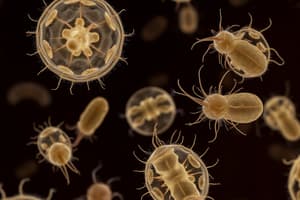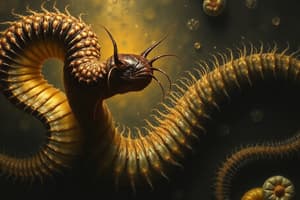Podcast
Questions and Answers
Which of the following is a characteristic of protozoans?
Which of the following is a characteristic of protozoans?
- They are autotrophic.
- They are aerobic and free living. (correct)
- They have a cell wall.
- They reproduce through binary fission.
Which of the following is a characteristic of pathogenic protozoa?
Which of the following is a characteristic of pathogenic protozoa?
- They are photosynthetic.
- They reproduce through sexual reproduction.
- They are multicellular.
- They are motile. (correct)
Which of the following is a characteristic of Plasmodia species?
Which of the following is a characteristic of Plasmodia species?
- They are ciliates.
- They have a complex life cycle.
- They infect red blood cells. (correct)
- They cause Leishmaniasis.
Which of the following is a characteristic of Babesia microti?
Which of the following is a characteristic of Babesia microti?
Which protozoan grouping is characterized by free-living organisms that feed by phagocytosis and move by extending pseudopodia?
Which protozoan grouping is characterized by free-living organisms that feed by phagocytosis and move by extending pseudopodia?
Which protozoan grouping is characterized by organisms that have whip-like projections called flagella and feed by cytostome?
Which protozoan grouping is characterized by organisms that have whip-like projections called flagella and feed by cytostome?
Which protozoan grouping is characterized by organisms that move by means of hair-like projections and feed by way of a cytostome groove?
Which protozoan grouping is characterized by organisms that move by means of hair-like projections and feed by way of a cytostome groove?
Which protozoan grouping is characterized by obligate intracellular parasites that possess a unique organelle called an apicoplast and an apical complex structure involved in penetrating a host's cell?
Which protozoan grouping is characterized by obligate intracellular parasites that possess a unique organelle called an apicoplast and an apical complex structure involved in penetrating a host's cell?
Which species of Plasmodium is most likely to result in death if left untreated?
Which species of Plasmodium is most likely to result in death if left untreated?
Which species of Plasmodium can infect erythrocytes of all ages?
Which species of Plasmodium can infect erythrocytes of all ages?
Which species of Plasmodium is associated with relapses from the liver?
Which species of Plasmodium is associated with relapses from the liver?
Which species of Plasmodium is characterized by the presence of Schuffner dots?
Which species of Plasmodium is characterized by the presence of Schuffner dots?
Which Plasmodium species is characterized by infected cells with Schüffner dots and ragged cell walls?
Which Plasmodium species is characterized by infected cells with Schüffner dots and ragged cell walls?
Which Plasmodium species is known to cause kidney damage (blackwater fever)?
Which Plasmodium species is known to cause kidney damage (blackwater fever)?
Which Plasmodium species selectively infects reticulocytes and accumulates in the bone marrow and liver?
Which Plasmodium species selectively infects reticulocytes and accumulates in the bone marrow and liver?
Which Plasmodium species has bar and band forms, with schizonts composed of eight merozoites in a rosette surrounding a pigment granule?
Which Plasmodium species has bar and band forms, with schizonts composed of eight merozoites in a rosette surrounding a pigment granule?
Which of the following is the vector responsible for spreading Malaria?
Which of the following is the vector responsible for spreading Malaria?
Which Plasmodium species is known to cause kidney necrosis and failure?
Which Plasmodium species is known to cause kidney necrosis and failure?
Which Plasmodium species produces hypnozoites in the liver that can remain dormant and recur months later?
Which Plasmodium species produces hypnozoites in the liver that can remain dormant and recur months later?
Which of the following is true about the life cycle of Apicomplexans?
Which of the following is true about the life cycle of Apicomplexans?
Which of the following is a risk factor for a Babesia microti and Babesia duncani infection in terms of regional prevalence and transmission vector or natural reservoir?
Which of the following is a risk factor for a Babesia microti and Babesia duncani infection in terms of regional prevalence and transmission vector or natural reservoir?
Which of the following is a diagnostic test result for Babesia?
Which of the following is a diagnostic test result for Babesia?
Which of the following is a clinical presentation of Leishmaniasis?
Which of the following is a clinical presentation of Leishmaniasis?
Can babesiosis be transmitted by transfusion in areas where it's not spread by ticks?
Can babesiosis be transmitted by transfusion in areas where it's not spread by ticks?
Which drug is still the drug of choice against all five species of Plasmodium, despite the emergence of drug resistance?
Which drug is still the drug of choice against all five species of Plasmodium, despite the emergence of drug resistance?
Which proposed mechanism of action involves binding to deoxyribonucleic acid (DNA) and interfering with DNA replication?
Which proposed mechanism of action involves binding to deoxyribonucleic acid (DNA) and interfering with DNA replication?
Which drug accumulates in tissue cells and destroys the extra-erythrocytic (hepatic) stages of malaria, resulting in a radical cure of the infection?
Which drug accumulates in tissue cells and destroys the extra-erythrocytic (hepatic) stages of malaria, resulting in a radical cure of the infection?
Which proposed mechanism of action involves raising the pH of the parasite's intracellular acid vesicles, thus interfering with its ability to degrade hemoglobin?
Which proposed mechanism of action involves raising the pH of the parasite's intracellular acid vesicles, thus interfering with its ability to degrade hemoglobin?
Which drug has a proposed mechanism of action involving the ability to form a nitro-anion radical metabolite, which reacts with the nucleic acids of the parasite, causing a significant breakage in the DNA?
Which drug has a proposed mechanism of action involving the ability to form a nitro-anion radical metabolite, which reacts with the nucleic acids of the parasite, causing a significant breakage in the DNA?
Which drug destroys the erythrocytic stage of malaria and may be used prophylactically to suppress clinical illness or therapeutically to terminate an acute attack?
Which drug destroys the erythrocytic stage of malaria and may be used prophylactically to suppress clinical illness or therapeutically to terminate an acute attack?
Flashcards are hidden until you start studying




